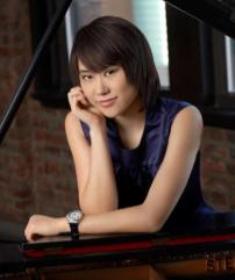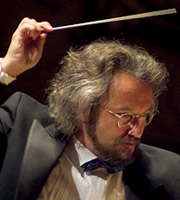
Yuja Wang is Here
Move over (fill in ”world’s greatest pianist”). Yuja Wang is here.

Born in
Beijing and now toppling pedestals worldwide, 23-year-old Wang made her
Cincinnati Symphony debut Friday night at Music Hall with a stunning
performance of Bartok’s Piano Concerto No. 2. Composed in 1931, it remains one of the most difficult in the repertoire,
but whether she was scooping up fists full of notes or racing across the
keyboard at lightning speed, it held no terrors for her.
Had there been a larger audience (tiny, even
without a competing Reds game), she might have played an encore, but it would
have been hard to top her performance with the well-oiled CSO led by guest
conductor Carlos Kalmar.

The concert had a Hungarian theme, opening with Liszt’s Hungarian Rhapsody No. 2 and ending with Brahms’ Piano Quartet No. 1 orchestrated by Arnold Schoenberg (famously Hungarian for its Gypsy Rondo finale).
Bartok’s music reflects the folk idioms of his native Hungary in a fully integrated way. The first movement of his Second Piano Concerto is set for piano, winds and brass (no strings), giving it a brilliant, extroverted sound. (The opening theme is reminiscent of the “Russian Dance” from Stravinsky’s “Petrouchka.”) There is constant interaction between soloist and orchestra and it was awe-inspiring to see Wang take on the CSO forces.
The second movement (Adagio) is an example of Bartok’s characteristic “night music,” opening with a gentle theme for muted strings, alternating with passages for piano and timpani alone. The central Presto bubbled up rapidly to a high note in the trumpet (effectively the keystone of the arch-like concerto) after which the Adagio returned, ending the movement as it began. For Wang, the Allegro molto finale, beginning with by a hefty thump on the bass drum, must have felt like being shot out of a cannon, but she kept up the furious pace with flying fingers. After a brief respite, it was back to the fray-for-all and a thunderous ending.
Everyone in cartoon land knows Liszt’s Hungarian Rhapsody No. 2, Bugs Bunny, Tom and Jerry, Roger Rabbit, even Woody Woodpecker. Kalmar, 52, music director of the Oregon Symphony, conducted the arrangement by German composer Karl Müller Berghaus, giving it considerable swagger. Clarinetist Jonathan Gunn shone in the introduction, while flutist Randolph Bowman and Joan Voorhees on piccolo had some pell-mell passages to negotiate in the frolicking conclusion.
Brahms’ Piano Quartet No. 1 in G Minor (for violin, viola, cello and piano) became a new creation when Schoenberg transcribed it in 1937. There is Brahms, of course, but get thee to a chamber music concert for the real thing. Schoenberg was one of the great orchestrators and he distributed Brahms’ materials over a very large ensemble. The result is a unabashedly romantic showpiece and Kalmar (Uruguayan of Austrian descent) treated it as such, reveling in its abundant color and gesture. Perhaps too much, for the pace sometimes slackened as he sought heightened drama and dwelt on particularly tasty moments.
The CSO did his bidding thoroughly, though they may have felt like a string about to break at times. There were many gorgeous moments, and Kalmar’s expressive conducting generated a great deal of excitement. The first movement (Allegro) proceeded well and the second movement (Intermezzo) was gentle and lilting, ending with a glint of triangle.
Things began to bog down in the Andante con moto, (“with motion” but less so here). The central, march-like portion lost impact, even on final repetition which sounded stilted, even hollow. The “Zingarese” (“gypsy style”) finale was justifiably showy, with the strings playing col legno (“with the wood” of the bow, nicely echoing the xylophone), “raspberries” in the brass and a lush episode for violas and cellos. Principal clarinetist Richard Hawley had a star turn, and there was a suave trio by concertmaster Timothy Lees, principal violist Christian Colberg and principal cellist Ilya Finkelshteyn, but again, the pace sometimes lagged. Kalmar lit a match under the final repetition of the rondo theme (Presto), earning a warm hand from the audience. Note: Like many of the CSO guest conductors this season, Kalmar (who has led the CSO in prior seasons as well) may be under scrutiny for the music director post to be vacated by Paavo Järvi next spring.
Repeat is 8 p.m. tonight at Music Hall. Tickets begin at $10. Call (513) 381-3300.
(first published in the Cincinnati Enquirer, October 18, 2010)